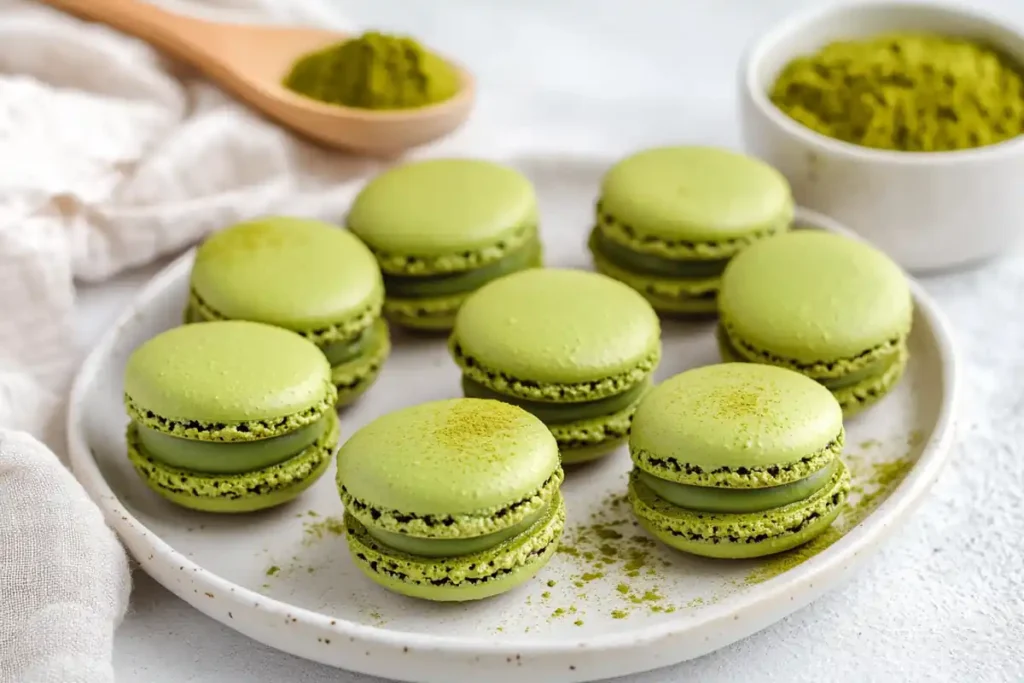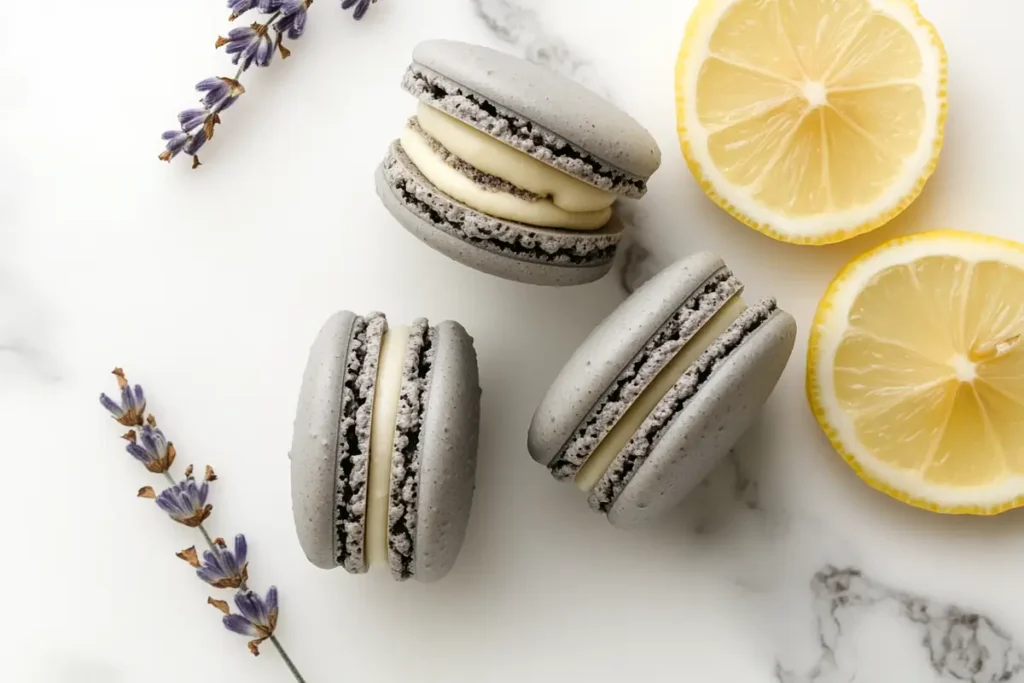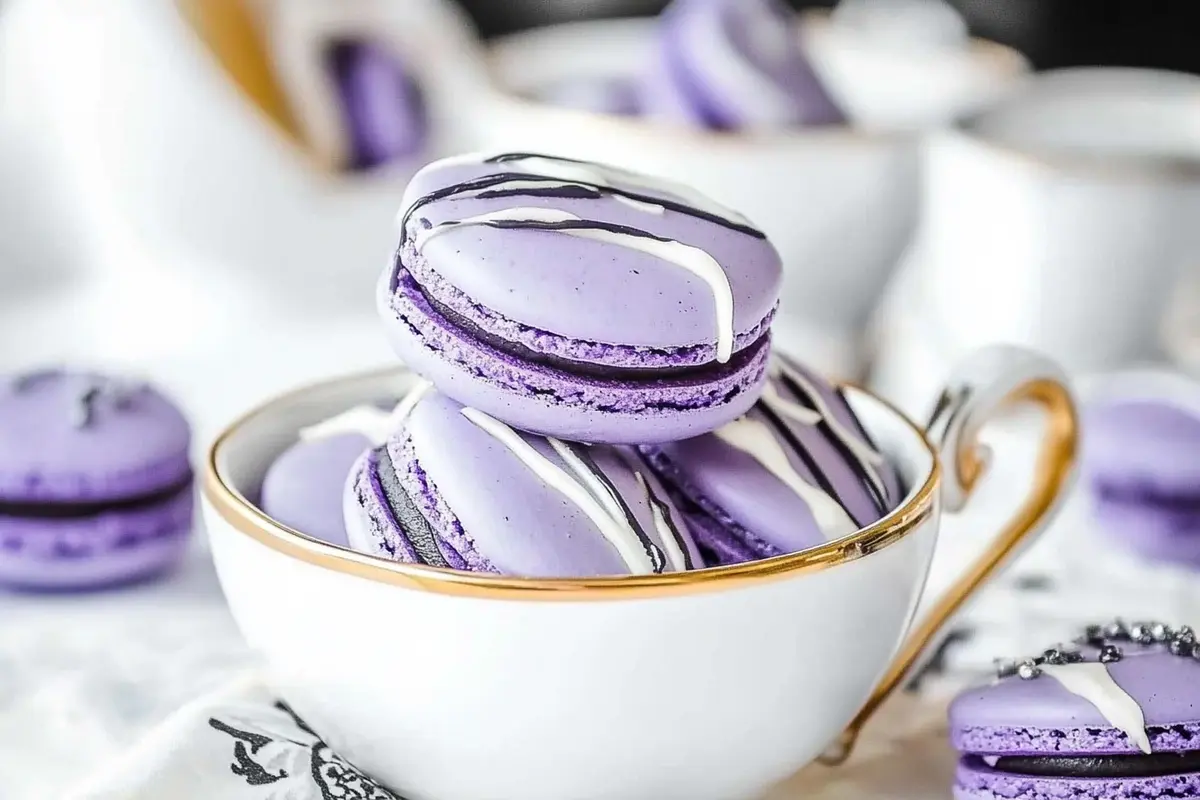Introduction:Tea Flavor for Macarons
Tea-flavored macarons have captured the hearts of dessert lovers worldwide. Combining the elegance of French pâtisserie with the comforting taste of tea, these treats are both unique and delicious. In this article, we’ll explore popular tea-infused macaron flavors, expert baking techniques, pairing ideas, and much more. Whether you’re a baking novice or a macaron aficionado, you’ll discover everything needed to master this delightful fusion.
Exploring the World of Tea-Flavored Macarons
The Fusion of Tea and French Pâtisserie
Tea and macarons might seem like an unlikely pair at first glance; however, their combination creates a delightful balance of sweetness and complexity. While macarons are known for their crisp outer shell and chewy interior, tea adds depth with its wide range of flavors. From earthy matcha to floral jasmine, tea enhances the macaron’s delicate structure by introducing subtle yet distinct notes.
Moreover, incorporating tea into macarons elevates the dessert beyond its classic version, making it a modern gourmet treat. As tea leaves steep, they release aromatic compounds that blend seamlessly with macaron fillings, creating a harmonious fusion of taste and texture. For this reason, tea-flavored macarons are popular among bakers seeking to create desserts that are both elegant and innovative. This creative union continues to captivate dessert enthusiasts worldwide.
Popularity and Appeal of Tea-Infused Macarons
Tea-flavored macarons have experienced a surge in popularity due to their distinctive taste, aesthetic appeal, and versatility. Their pastel-toned shells, often inspired by the natural colors of tea leaves, make them visually captivating. Additionally, the unique blend of sweet macaron shells and tea-infused fillings creates an irresistible treat perfect for any occasion.
In recent years, tea-flavored macarons have become must-have items at events like weddings, bridal showers, and afternoon tea parties. Event organizers love their elegant appearance and customizable flavors, while guests appreciate the delicate balance of familiar tea notes in every bite. Furthermore, home bakers and professionals alike enjoy experimenting with different tea varieties, making the creative possibilities endless.
Ultimately, the combination of visual beauty, exceptional taste, and versatility makes tea-flavored macarons a beloved choice for both casual indulgence and special celebrations. They offer a refined dessert experience that appeals to all the senses, ensuring their continued popularity in the world of modern pâtisserie.
Understanding Macarons and Tea Infusions
What Are Macarons?
Macarons are delicate, meringue-based cookies made with almond flour, egg whites, and sugar. Their signature feature is a smooth, shiny shell with a chewy interior, sandwiched around a flavorful filling like buttercream, ganache, or jam. These elegant treats have become synonymous with French pâtisseries but have roots in Italian baking traditions. Although they seem complex, macarons are surprisingly achievable with the right techniques and precise measurements.
Brief History of Macarons
The macaron’s journey began in Italy, where it was first crafted as a simple almond-based cookie. In the 16th century, Queen Catherine de’ Medici’s pastry chefs introduced the recipe to France. As time passed, French bakers refined the macaron, transforming it into the elegant, filled dessert we know today. Consequently, the macaron gained popularity worldwide, symbolizing sophistication and indulgence. Furthermore, its adaptability has made it a favorite in modern dessert creations.
Traditional Ingredients and Structure of Tea Flavor for Macarons
Classic macarons consist of three main components:
- Macaron Shells: Made with almond flour, powdered sugar, egg whites, and granulated sugar, providing structure and a smooth texture.
- Filling: Typically buttercream, ganache, or fruit-based spreads, adding flavor and creaminess.
- Flavoring and Coloring: Extracts or powders enhance taste and create visually appealing desserts.
Moreover, bakers often experiment with unique flavors and natural colors, ensuring that each macaron batch is both delicious and visually stunning. To achieve consistency, precise measurements and careful mixing are essential throughout the process.
The Art of Tea Infusion in Baking
Infusing tea into baked goods is an art that requires precision, creativity, and attention to detail. Tea’s aromatic compounds can transform standard recipes into gourmet delights by adding depth and complexity. From subtle floral hints to robust earthy tones, tea-based desserts offer a sensory experience unmatched by other flavorings. As a result, incorporating tea into macarons has become a popular trend among pastry chefs and home bakers alike.
Techniques for Infusing Tea Flavors into Desserts
- Steeping in Liquids: Simmer tea leaves in milk, cream, or water to extract maximum flavor for fillings or batters. This method ensures that the macaron’s filling absorbs the tea’s essence while retaining a smooth texture.
- Powdered Tea Additions: Use finely ground teas like matcha directly in macaron shells or fillings for bold, distinctive flavors. This technique works well for teas with intense color and taste.
- Tea-Infused Syrups: Create flavorful syrups by boiling tea leaves with sugar and water, ideal for glazing or sweetening fillings. This method enhances both taste and appearance.
By mastering these techniques, bakers can create macarons that are flavorful, aromatic, and visually stunning. Incorporating tea allows for endless flavor possibilities, transforming simple recipes into extraordinary culinary masterpieces.
Benefits of Using Tea in Macarons
- Natural Flavor Enhancement: Tea offers a wide spectrum of natural flavors without artificial additives, making it perfect for gourmet treats.
- Aromatic Appeal: Infused macarons release captivating aromas that elevate dessert presentations, enticing both the eyes and the taste buds.
- Health Perks: Teas like green or herbal varieties add antioxidants and other health-boosting properties, making macarons a slightly healthier indulgence.
By thoughtfully incorporating tea into macarons, bakers can balance sweetness while adding depth and sophistication. Additionally, using tea ensures that each bite is a blend of deliciousness and aromatic pleasure, creating an unforgettable dessert experience
Popular Tea Flavors for Macaron
Matcha (Green Tea) Macarons

Unique Flavor Profile of Matcha
Matcha is renowned for its earthy, slightly bitter taste with a hint of sweetness. Its robust flavor balances the sweetness of macaron shells, creating a harmonious blend. Matcha’s intense green hue also lends a visually striking appearance, making these macarons as beautiful as they are delicious.
Health Benefits Associated with Matcha
Matcha is rich in antioxidants, particularly catechins, which combat free radicals. It boosts metabolism, promotes relaxation due to its L-theanine content, and supports heart health. This makes matcha macarons a tasty treat with added wellness benefits.
Recipe Overview for Matcha Macarons
Ingredients:
Macaron shells: almond flour, powdered sugar, egg whites, granulated sugar, and matcha powder.
Filling: Matcha-infused white chocolate ganache or buttercream.
Method: Incorporate matcha powder into the dry ingredients for the shells. Prepare a matcha-infused ganache by steeping matcha in heated cream before blending with white chocolate. Pipe the filling between cooled shells.
Earl Grey Macarons

Distinctive Taste of Bergamot in Earl Grey
Earl Grey tea is distinguished by its citrusy bergamot aroma. This floral-citrus essence creates a sophisticated flavor profile, adding depth and subtle complexity to macarons.
Pairing Earl Grey with Complementary Fillings
Lavender Buttercream: Enhances the floral notes.
Honey or Vanilla Ganache: Balances citrus sharpness with sweetness.
Recipe Overview for Earl Grey Macarons
Ingredients:
Macaron shells: almond flour, powdered sugar, egg whites, and a touch of food coloring (soft gray or lavender).
Filling: Earl Grey-infused white chocolate ganache.
Method: Steep Earl Grey tea leaves in warm cream, then mix with melted white chocolate to create a luscious filling. Pair with classic macaron shells.
Jasmine Tea Macarons
Delicate Floral Notes of Jasmine Tea
Jasmine tea is prized for its light, floral aroma with sweet, fragrant undertones. Its subtle taste infuses macarons with an elegant, aromatic finish that is both calming and luxurious.
Ideal Occasions for Serving Jasmine Macarons
These macarons are perfect for bridal showers, afternoon tea parties, or festive spring gatherings due to their gentle floral essence and soft pastel hues.
Recipe Overview for Jasmine Tea Macarons
Ingredients:
Macaron shells: almond flour, powdered sugar, egg whites, and food coloring (soft pink or white).
Filling: Jasmine-infused white chocolate ganache.
Method: Infuse cream with jasmine tea leaves, strain, and blend with melted white chocolate. Pipe between cooled macaron shells for a delicate finish.
Chai-Spiced Macarons
Warm and Spicy Flavor Profile of Chai
Chai tea boasts a bold blend of warming spices like cinnamon, cardamom, cloves, and ginger. This rich, spicy medley brings comforting warmth and depth to macarons, making them perfect for colder months or festive occasions.
Incorporating Chai Spices into Macaron Shells and Fillings
Macaron Shells: Add ground cinnamon, cardamom, and nutmeg directly to the shell mixture.
Filling: Chai-infused buttercream or spiced white chocolate ganache.
Recipe Overview for Chai-Spiced Macarons
Ingredients:
Macaron shells: almond flour, powdered sugar, egg whites, chai spices (cinnamon, ginger, cardamom).
Filling: Chai-spiced buttercream or white chocolate ganache.
Method: Infuse warm cream with chai spices, strain, and combine with softened butter or melted white chocolate. Pipe this rich, spiced filling between the macaron shells for an irresistible treat.
Techniques for Making Tea-Flavored Macarons
Selecting Quality Tea for Baking
Choosing the right tea is essential for achieving bold, authentic flavors in macarons. Since tea quality directly impacts taste, bakers should select fresh, aromatic varieties. The right tea can transform a simple dessert into a luxurious treat.
Loose Leaf vs. Tea Bags
- Loose Leaf Tea: Offers superior flavor due to larger, whole leaves that retain essential oils. Best for infusions and grinding into powders.
- Tea Bags: Convenient but often contain lower-grade, finely chopped tea leaves. Use only when brewing strong infusions.
Optimal Tea Varieties for Macarons
- Green Tea (Matcha): Earthy and slightly bitter, perfect for balancing sweetness.
- Black Tea (Earl Grey, Chai): Bold and aromatic, great for robust fillings.
- Floral Teas (Jasmine, Lavender): Delicate and fragrant, ideal for light, elegant macarons.
Methods of Infusing Tea into Macaron Components
Infusing Tea into Buttercream Fillings
Steep tea leaves in heated cream or milk, then strain before incorporating into buttercream. For strong flavor, use concentrated tea extracts or add powdered teas like matcha directly to the mixture.
Incorporating Tea Powders into Macaron Shells
Finely ground tea powders can be mixed into the almond flour and powdered sugar. This method works well for teas like matcha, chai, or Earl Grey, ensuring even distribution of flavor and color.
Creating Tea-Infused Ganache
Steep tea leaves in warm cream, strain, and mix with melted white or dark chocolate. This ganache works as a macaron filling or drizzle. Adding honey or vanilla can enhance the flavor complexity.
Troubleshooting Common Issues in Tea-Flavored Macarons
Achieving Balanced Tea Flavor Without Bitterness
- Use the correct steeping time to avoid bitterness, especially with green or black teas.
- Sweet fillings like vanilla or white chocolate can offset strong tea flavors.
Maintaining Macaron Texture with Added Ingredients
- Avoid adding too much tea powder to the shell batter, which can affect its delicate structure.
- Infuse tea into liquids rather than adding it directly to ensure a smooth texture.
Adjusting Baking Times for Tea-Infused Batters
- Tea-infused batters may require slightly longer baking times due to added moisture.
- Use an oven thermometer to maintain consistent baking temperatures and avoid overbaking.
Pairing and Serving Suggestions for Tea Flavor for Macarons
Complementary Beverages for Tea-Flavored Macarons
Pairing macarons with the right beverages enhances the overall tasting experience by balancing sweetness and emphasizing their delicate tea-infused flavors. Thoughtful combinations can elevate a simple dessert into a sophisticated culinary experience. Let’s explore some perfect beverage pairings:
Pairing with Different Types of Tea
Pairing macarons with matching tea varieties intensifies their unique flavors. Consider these carefully selected combinations:
- Matcha Macarons: A light jasmine or white tea complements the earthy notes of matcha while adding a gentle floral aroma.
- Earl Grey Macarons: Serve with black tea or herbal infusions like lavender or chamomile for added citrus and floral depth.
- Chai-Spiced Macarons: Complement them with spiced teas or a creamy chai latte, enhancing the warm, spiced profile of the macaron.
The interplay of similar and contrasting flavors creates a well-rounded tasting experience, making every bite more enjoyable.
Coffee and Other Beverage Pairings
Although tea is a natural companion to tea-flavored macarons, coffee also works well, offering contrasting notes that balance sweetness:
- Espresso: Its bold intensity cuts through the sweetness of macarons, highlighting both the macaron’s texture and its tea-infused filling.
- Latte or Cappuccino: Creamy milk-based drinks soften strong tea flavors, creating a harmonious balance with the macaron’s delicate structure.
These versatile pairings cater to diverse preferences, ensuring guests enjoy an unforgettable dessert experience regardless of their beverage of choice.
Presentation Ideas for Tea-Infused Macarons
Creating an inviting presentation enhances both the visual appeal and tasting experience of tea-flavored macarons. Consider these expert styling tips:
Color Coordination and Garnishes
Presentation is as essential as flavor when serving macarons. For an elegant display, match macaron shell colors to their corresponding tea flavors:
- Green for Matcha: Symbolizing freshness and vibrancy.
- Beige for Chai: Representing warmth and comfort.
- Lavender for Earl Grey: Conveying sophistication and calmness.
To enhance their appearance, add edible garnishes such as tea leaves, dried flowers, or a light dusting of powdered tea. These small touches create an aesthetically pleasing dessert table that impresses guests.
Themed Serving Platters for Various Occasions
Tailoring the presentation style to the occasion adds an extra layer of sophistication. Consider the following setups:
- Formal Events: Use tiered dessert stands with matching china for an upscale, elegant look. Include elegant labels identifying flavors to guide guests effortlessly.
- Cozy Gatherings: Choose rustic wooden boards or vintage tea trays for a warm, inviting atmosphere. Pair them with soft linen napkins and decorative tea sets for added charm.
By carefully selecting serving platters and matching themes to the event, you create a visually stunning and memorable dessert presentation that guests will adore.
FAQs About Tea-Flavored Macarons
What is the best way to flavor macarons?
The best way to flavor macarons is by using concentrated, high-quality ingredients that won’t alter the batter’s texture. Infusing liquids like cream or milk with tea leaves works well for fillings such as buttercream or ganache. Additionally, using powdered teas like matcha or ground Earl Grey directly in the macaron shell mixture ensures a well-rounded flavor. Extracts and natural flavorings can also enhance the taste without compromising the delicate texture of the shells.
What is macaron tea?
Macaron tea refers to tea-inspired macaron flavors, where tea leaves or powders like matcha, Earl Grey, or chai are used to infuse the dessert. These tea-flavored macarons capture the essence of popular tea varieties, blending them into fillings or macaron shells. The result is a unique and delicious treat that tea enthusiasts love.
How unhealthy is a macaron?
Macarons are relatively low in calories compared to other desserts, with an average macaron containing about 70-100 calories. They are gluten-free but still high in sugar due to the sweet fillings and shells. While not a health food, macarons can be enjoyed in moderation as part of a balanced diet. Choosing tea-infused macarons can add subtle nutritional benefits, such as antioxidants from teas like matcha or green tea.
What are the three types of macaron?
The three main types of macarons are based on preparation styles:
- French Macarons: Made with a simple meringue of whipped egg whites and sugar. This is the most common and delicate type.
- Italian Macarons: Involves cooking sugar syrup before adding it to whipped egg whites, resulting in a more stable batter.
- Swiss Macarons: Uses a Swiss meringue method where egg whites and sugar are whisked over heat before being whipped into stiff peaks.
These techniques vary in complexity but produce equally delicious and visually stunning macarons.
Conclusion of tea-flavor-for-macarons
Embracing Creativity with Tea-Flavored Macarons
Tea-flavored macarons open a world of culinary possibilities by blending the rich traditions of tea with the elegance of French pâtisserie. Their unique taste profiles, ranging from earthy matcha to fragrant jasmine, allow bakers to craft visually stunning and flavorful treats. These macarons appeal not only to tea enthusiasts but also to dessert lovers seeking sophisticated and memorable confections.
Moreover, the versatility of tea-based flavors inspires endless creativity in the kitchen. Whether adding floral notes for a light dessert or infusing bold spices for a winter treat, tea-based macarons can be customized for any occasion. Because of this, they have become a popular choice for special events, afternoon tea parties, and even everyday indulgence.
Encouragement to Experiment with Different Tea Varieties
Baking with tea invites endless creativity and experimentation, encouraging bakers to explore beyond traditional flavors. For instance, experimenting with herbal teas like chamomile, hibiscus, or lemongrass can introduce refreshing and unexpected notes. Similarly, spiced teas such as masala chai or rooibos add warmth and depth, perfect for seasonal treats.
Additionally, blending teas can create custom flavor profiles that stand out. Adjusting steeping times or combining different varieties ensures a unique macaron experience every time. Therefore, bakers should feel free to try new teas, experiment with ratios, and infuse fillings in creative ways. Customizing macarons with personalized tea blends turns each batch into a signature dessert masterpiece.
Final Thoughts on the Fusion of Tea and Macarons
The fusion of tea and macarons is undoubtedly a match made in dessert heaven. By mastering tea infusion techniques and exploring innovative pairings, bakers can elevate their dessert repertoire. The delicate shells of macarons combined with rich tea-infused fillings offer an exceptional balance of taste, aroma, and visual appeal.
Whether you’re preparing an elegant tea party or crafting a special gift, tea-flavored macarons are guaranteed to impress. Their unique fusion of traditional baking and tea artistry makes them timeless yet modern. So, enjoy the adventure of crafting these exquisite treats, and let your imagination guide you toward creating macarons that are as flavorful as they are beautiful.

